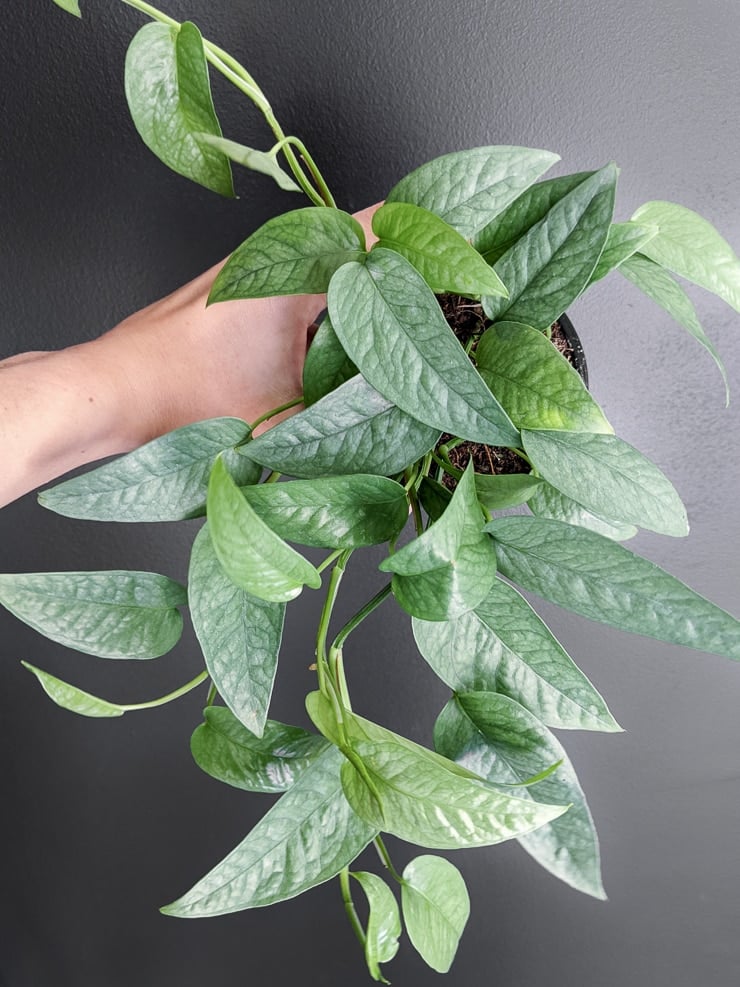I’m on a mission to collect all of the Costa Farms Trending Tropicals plants this year! And I finally got my hands on an Epipremnum pinnatum Baltic Blue pothos. Learn all about its care and propagation.
Baltic blue pothos care & propagation
I have been on a mission to collect all of the Costa Farms 2022 Trending Tropicals plants, and I finally got my hands on a Baltic Blue pothos! I love pothos and have written about the different pothos varieties you can collect in the past.
I also have detailed care guides for many of my favorites, including cebu blue pothos care, marble queen pothos care, global green pothos care, and more.

Aureum vs. pinnatum
All of the pothos varieties I own are either Epipremnum aureum or Epipremnum pinnatum. Epipremnum is the genus that both aureum and pinnatum live in. Aureum is the more common variety of pothos, and it includes golden, marble queen, jade, global green, and many more.
The leaves on aureum pothos plants are generally wider and more heart-shaped than pinnatum leaves. Aureum species plants climb and trail, but most plants you’ll find in nurseries will be in small pots or hanging baskets.
Epipremnum pinnatum, however, is a different species. It’s closely related, but there are some obvious differences. The leaves on pinnatum pothos plants are generally longer and more narrow. These include varieties you may have heard of like cebu blue, Epipremnum pinnatum albo variegata, and today’s plant—Baltic Blue.
They climb and trail as well, but you’ll generally find them in smaller pots (since they are often harder to find). It’s also a good idea to have these little guys climb if you want their leaves to mature and fenestrate (split). More on that in a bit.


Baltic Blue pothos vs. Cebu Blue pothos
These plants are both Epipremnum pinnatum varieties, but they are different plants. Cebu blue climbs and trails, but it has more textured leaves and a more minty, silvery appearance. It also requires climbing to fenestrate (split).
If you let a cebu blue pothos plant trail, it will still grow nicely. However, the leaves will not fenestrate, and they will also begin to grow a bit smaller.
Baltic Blue pothos does not have the silver sheen, and its leaves are not as much of a bluish-green. Baltic Blue also begins to fenestrate earlier than other pothos plants.
And the cool thing about Baltic Blue is that the leaves will grow in size even without a climbing apparatus like a trellis or moss pole. So how you display it is really up to you. Pot on a table, hanging basket, with or without a pole or trellis…it’s your call.


How much light does a Baltic Blue pothos need?
The lighting needs for Baltic Blue pothos mirror those of most other pothos plants. The plant’s deep green leaves have blue undertones, and they thrive in anywhere from medium to bright light.
That means that you can put it anywhere near a sunny window. I generally put plants like this one to several feet away from a west- or east-facing window. Though this plant will probably be fine in a north-facing window.
If you have it on a south-facing window, just be cognizant of how much strong light you’re getting. This placement could be fine in the spring, fall, and winter, but summer sun might be too strong even indoors.
Direct light can burn the leaves, so if you’re taking it outside for the spring and summer, make sure it’s in bright shade. If you have to have it somewhere that gets direct sun, weaker direct morning sun is best.
Want to learn more about indoor plant lighting? Check out my post about how to use grow lights with houseplants!



Water & soil needs
Water and soil go hand-in-hand, so I’ve started writing about them together in my newer plant care posts. Baltic Blue pothos enjoys well-draining soil, and it will likely be totally fine in all basic indoor or houseplant soil mixes.
I generally like to buy these mixes and throw in an additional handful of perlite, coco coir (a great peat moss alternative), or both. Just depends on the plant. I won’t be repotting my Baltic Blue pothos until at least the spring or summer.
But the soil it came in is generally a good indicator of what the plant likes. And it’s in a very airy soil—something with a lot of what looks like moss or coco coir. These additives allow the soil to drain completely when you water the plant.
This ensures the plant’s roots get all of the moisture they need without waterlogging the soil. If your soil is too dense, the plant will suffer from root rot and die. Signs of a dying, over-watered plant are wilted, yellowing leaves.
For more on houseplant soil amendments, read my houseplant soil 101 post!
You should let the soil mix dry out almost all the way between watering sessions. If you let it dry out completely, you’ll notice the leaves begin to wilt. The plant will rebound if you don’t let it go too far without water, but don’t make this a habit.
I generally water my pothos plants weekly in the spring and summer, usually every 2 weeks or so in the late fall and winter. Colder temperatures and less light means that the plant will need less water.



Temperature & humidity requirements
Baltic Blue pothos plants do well in a variety of normal household temperatures and humidity levels. That’s why pothos plants are such great choices as houseplants, and Baltic Blue pothos is no different.
Don’t leave your pothos plant outside when the temperatures drop into the 40s consistently at night, though. This plant is not cold-tolerant, and it definitely won’t survive a frost.
Your plant will enjoy extra warmth and extra humidity, though. So adding a humidifier to your setup is helpful. Or, if you live somewhere humid like we do, you can move your plant outdoors to a bright shaded spot for the spring and summer.
You’ll notice that, while the Baltic Blue pothos does great in normal humidity levels, it will do really great with some extra humidity! I have found this to be true among all of my pothos plants.


Pruning leggy growth
Pruning trailing plants is a great way to encourage bushier growth. If you notice that your plant is getting leggy-—meaning that there is more space growing between new leaves—you can prune off that growth.
This will encourage fullness in the plant by sprouting a new growth point just above where you snipped. Since this growth point doesn’t grow completely straight and branches out a bit, it helps with some of the leginess.
You can also prune your plant even if it isn’t leggy. Maybe you just want to keep it smaller or you want to give away cuttings. That’s fine, too. Pothos plants won’t throw a fit when you trim them—in fact, I’ve found that it is really helpful for healthy new growth!



How to propagate Baltic Blue pothos cuttings
And pruning time is a great excuse to dive into propagation, too. You may even be reading this because you got a cutting from someone and are wondering how to propagate Baltic Blue pothos. I’ve got you!
Pothos plants are some of the easiest plants to propagate. In fact, my post on how to propagate pothos cuttings was the first plant propagation post I ever wrote! It uses golden pothos cuttings as an example, but the process is pretty much the same. I also have a cebu blue pothos cutting propagation post.
Keep in mind that, whichever propagation method you choose for your Baltic Blue pothos cutting, you’ll want to propagate in the spring or summer when growing conditions are best. If you propagate in the fall or winter, invest in a heat mat and grow lights (that’s what I do).

Baltic Blue pothos water propagation
I generally don’t like using water propagation since the roots suffer more shock when transplanting the rooted cuttings to soil. However, pothos plants do very well with water propagation!
The roots grow very well, and while the plant does suffer from some transplant shock after you move it to soil, it will rebound. Simply take a cutting with one or two growth points on it (look for the nubs that grow aerial roots, or remove the bottom set of leaves).
Then keep it in water for several weeks. Refresh the water every week or so, and monitor to make sure it isn’t evaporating below the growth points. Once the roots are several inches long, you can transplant the cutting to fresh, well-draining soil.

How about other propagation methods?
There are so many other propagation methods you can try out, too. For pothos plants, I’ve enjoyed using LECA as a propagation medium. LECA are clay balls that you keep a reservoir of water in. Your cutting, nestled in the clay balls, soaks up that water through the clay balls.
I love LECA propagation because it encourages really strong root growth. You’ll definitely notice that the roots look different when compared to water propagation. You can read more about LECA propagation in this post.
Sphagnum moss and perlite is also a good option. You’ll need to monitor your cutting closely with this method to ensure the medium doesn’t dry out all the way. And it can dry out quickly!
Moss and perlite is perfect for DIY plastic plant propagation boxes where humidity stays high. Or you can put the mixture and cutting in a little container and put a plastic bag over it. Read all about sphagnum moss and perlite propagation for more.
Finally, you could skip over all of these ideas and put your cutting straight into soil. This is my least favorite method to propagate because, while it is easiest, I can’t monitor root growth. And it’s hard to monitor the soil moisture levels.
If you do choose to propagate a Baltic Blue cutting directly in soil, I’d recommend dipping it in rooting hormone powder first. Then plant it in fresh, well-draining soil. Keep the soil moist but not too wet.
Higher humidity levels are also helpful—as is some indirect light. After several weeks, you can gently tug you cutting to see if you get any resistance. If you do, it has started rooting. After another week or two, you can back off watering so you don’t drown the plant.


Pin my Baltic Blue pothos care & propagation guide!


Brittany is a seasoned DIY home and garden expert, running a creative brand since 2014 that inspires others with approachable plant care guides, woodworking tutorials, and decor projects. She is a certified project manager and has completed extensive coursework in the art and science of growing your own plants. Her work has been recognized by major publications, and she routinely collaborates with fellow DIY industry leaders—but her favorite thing to do is inspire you! Learn more about her here.

Leave a comment